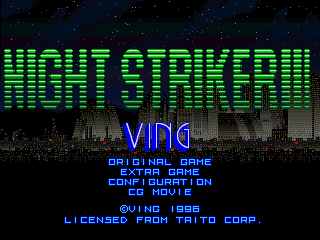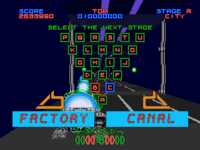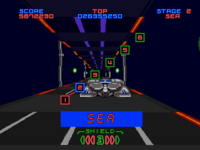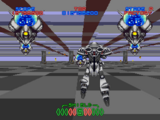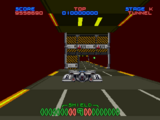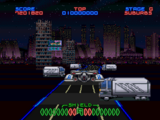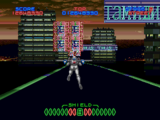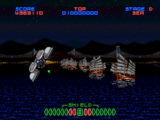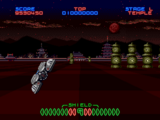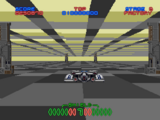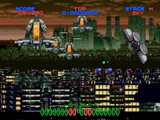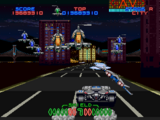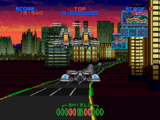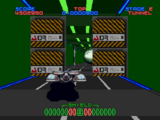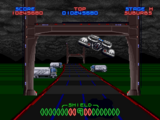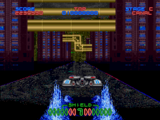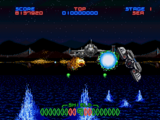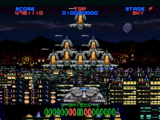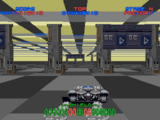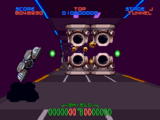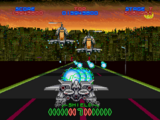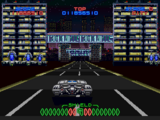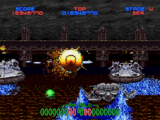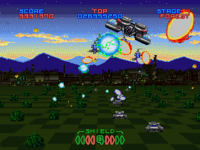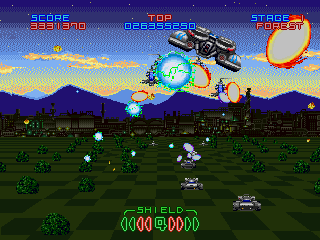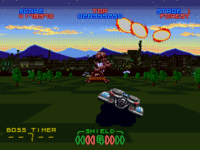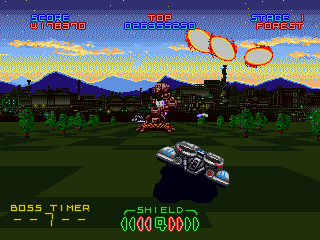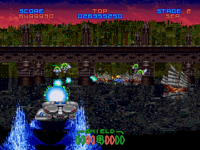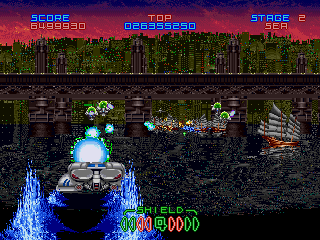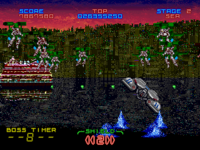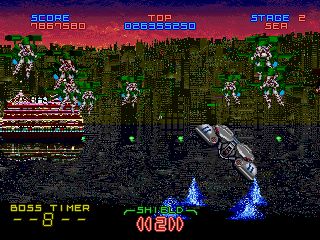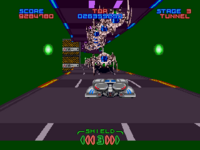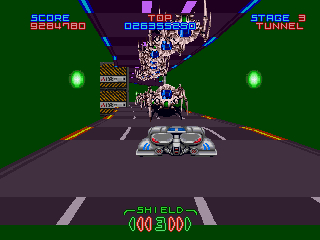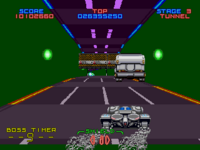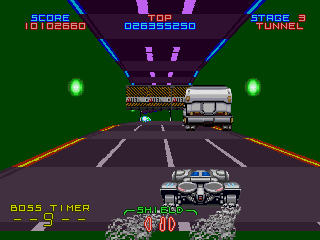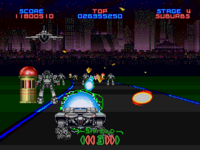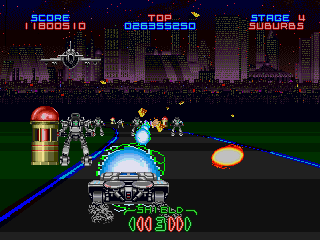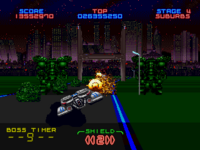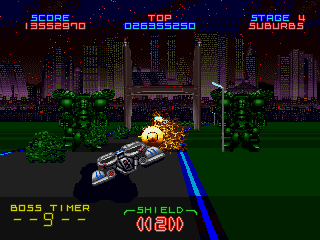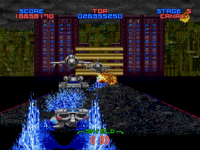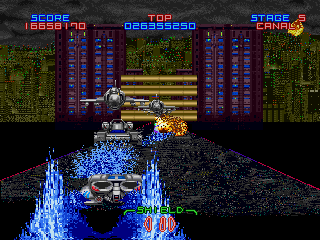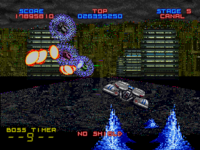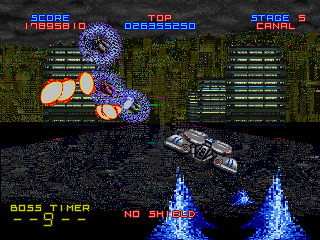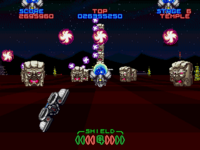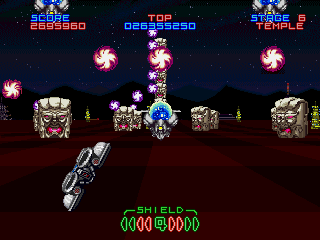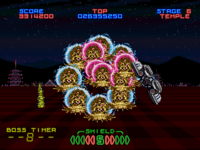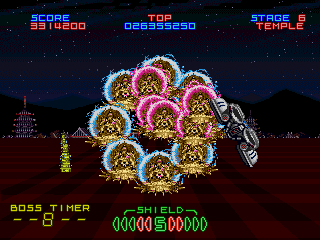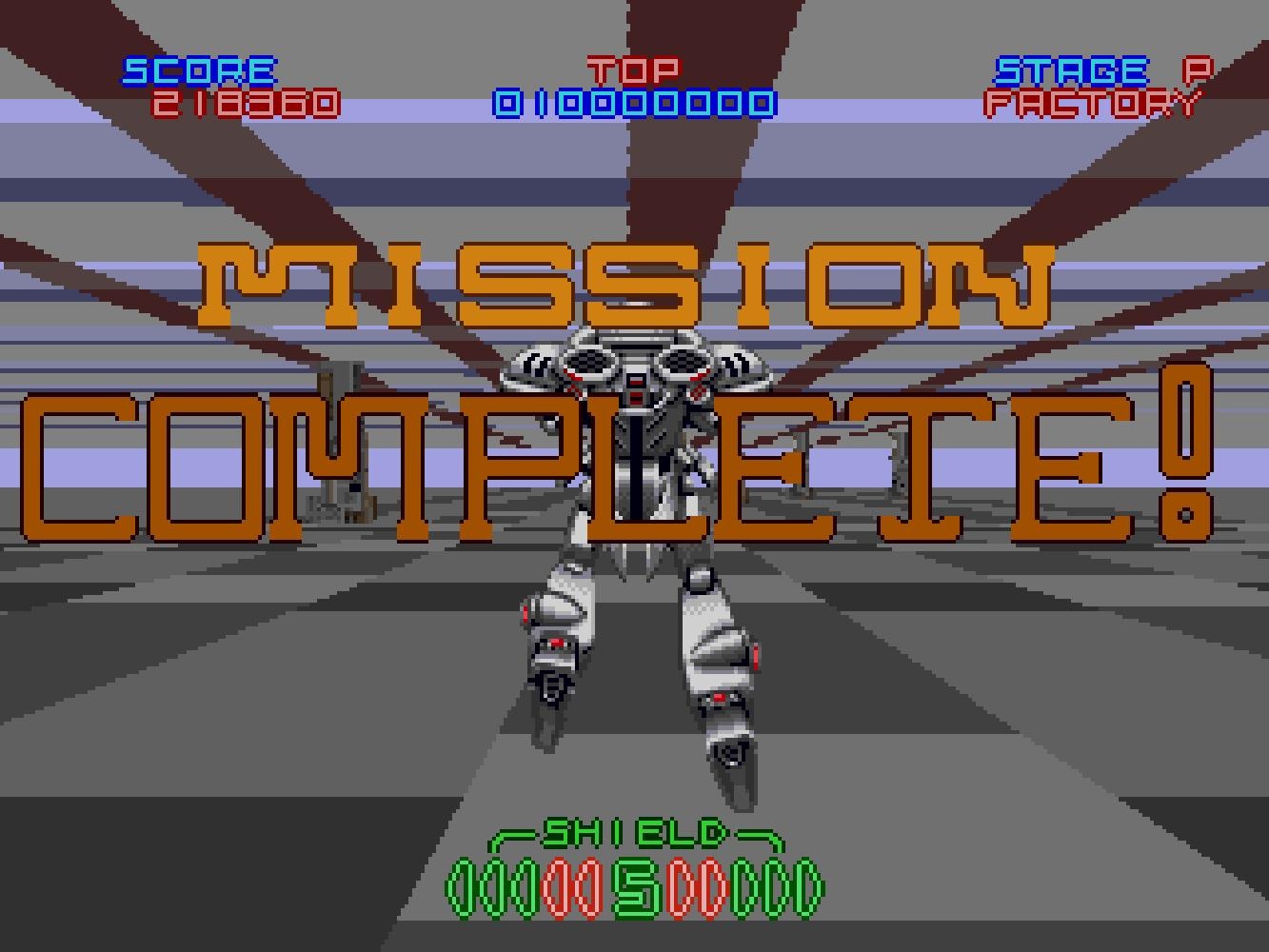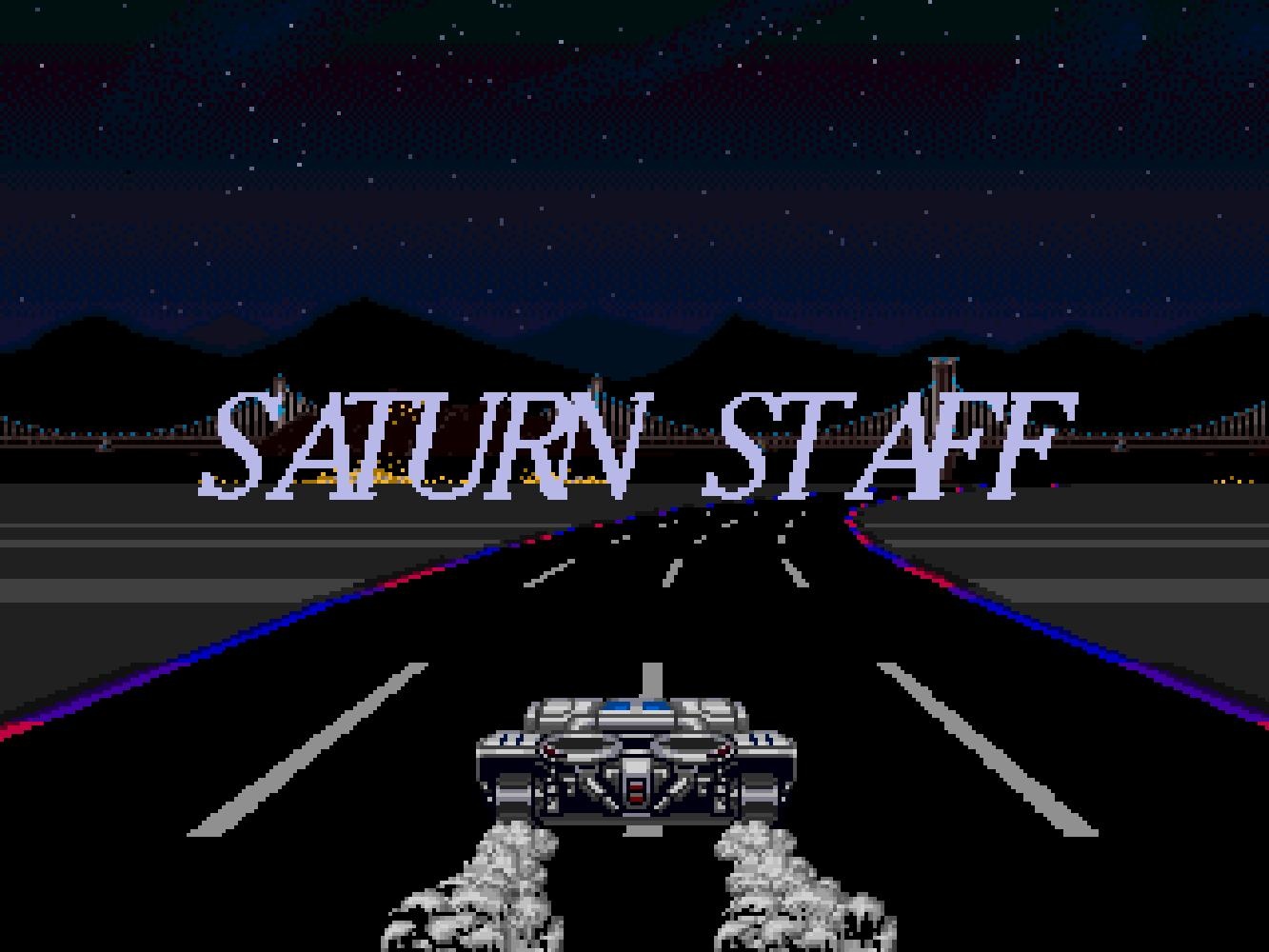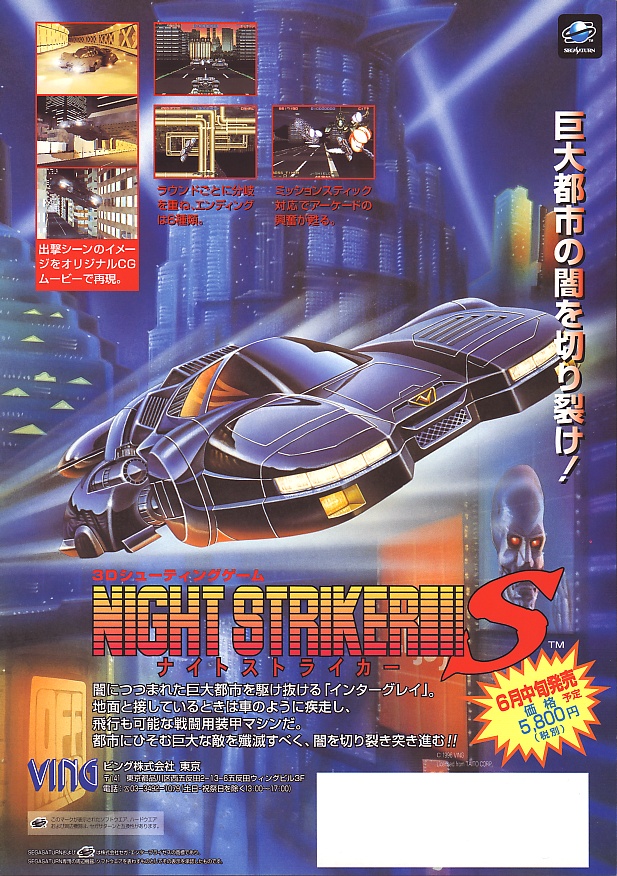Difference between revisions of "Night Striker S"
From Sega Retro
(expanded) |
|||
| (2 intermediate revisions by 2 users not shown) | |||
| Line 4: | Line 4: | ||
| publisher=[[Ving]] | | publisher=[[Ving]] | ||
| developer=[[Fill in Cafe]] | | developer=[[Fill in Cafe]] | ||
| + | | licensor=[[Taito]] | ||
| system=[[Sega Saturn]] | | system=[[Sega Saturn]] | ||
| − | | sounddriver= | + | | sounddriver=SCSP/CD-DA (18 tracks) |
| − | | peripherals= | + | | peripherals=[[3D Control Pad]], [[Mission Stick]] |
| players=1 | | players=1 | ||
| genre=3D Shooting{{fileref|NightStriker Saturn JP Box Back.jpg}}, Shooting{{ref|https://web.archive.org/web/20200320230509/https://sega.jp/fb/segahard/ss/soft_licensee2.html}} | | genre=3D Shooting{{fileref|NightStriker Saturn JP Box Back.jpg}}, Shooting{{ref|https://web.archive.org/web/20200320230509/https://sega.jp/fb/segahard/ss/soft_licensee2.html}} | ||
| − | |||
| originalsystem=Arcade boards | | originalsystem=Arcade boards | ||
| releases={{releasesSat | | releases={{releasesSat | ||
| Line 19: | Line 19: | ||
| otherformats={{NonSega|Arcade|PS}} | | otherformats={{NonSega|Arcade|PS}} | ||
}} | }} | ||
| − | + | '''''{{PAGENAME}}''''' (ナイトストライカーS ) is an arcade game developed by [[Taito]]. It is a futuristic on-the-rails shooter which plays similarly to [[Sega]]'s ''[[Space Harrier]]'', with the player piloting a hover vehicle. | |
| − | |||
==Story== | ==Story== | ||
| − | + | The game is set in a futuristic city in 2049. A terrorist organisation has kidnapped Doctor Masker Lindberry and his daughter. The United Nations Special Service Agency has dispatched their agents to investigate, but to no avail. Its leader is leading a task force, code-named Night Striker, using armoured vehicles to rescue them and destroy the organisation. | |
==Gameplay== | ==Gameplay== | ||
| − | {{ | + | {{ScreenThumb|NightStriker Saturn JP SSSelect.png|width=200|Branching paths in Original Game}} |
| + | {{ScreenThumb|Night Striker Saturn, Extra Game, Next Stage.png|width=200|Next stage in Extra Game}} | ||
| + | The game is a rail shooter with a 3D perspective. The player controls a hover car and shoots enemies encountered during the stage. The car moves by holding in any direction with the D-Pad. The player does not control the speed at which the car travels through the stages. The car shoots by pressing any button; {{A}}, {{X}}, or {{L}} can be held for continuous fire. | ||
| + | |||
| + | The car has a shield that can absorb a certain number of hits before being destroyed. The car is harmed by enemy fire or running into obstacles, but it is not harmed by touching walls or ceilings. The player is given additional shield points (up to a maximum of 9) after completing each stage. If the shield has run out, the car can sustain one more hit before it is destroyed and the game is over. The game can be continued if the player has credits remaining. | ||
| + | |||
| + | There are two modes: original game and extra game. In either mode, the game is broken into multiple stages, each concluding with a boss. In the Original Game mode, the player can choose between two different routes for the next stage, similar to ''[[OutRun]]''. There are 21 stages, but the player only needs to complete 6 to complete the game. In the final stages, the car transforms into different vehicles such as a motorbike or a robot. The game features different endings depending on which route is taken. In the Extra Game mode, there are another 6 stages to play, but they are always played in the same order rather than having branching paths. | ||
| + | |||
| + | In the options, the player can choose between two control methods (Normal for vertical controls and Reverse for inverted vertical controls). The Auto Neutral option toggles whether the car moves back into the center of the screen when the player is not holding a direction. There are four different difficulty levels (Easy, Normal, Hard, and Very Hard). | ||
| + | |||
| + | ===Stages=== | ||
| + | ====Original Game==== | ||
| + | {{OutRunRoute | | ||
| + | {{OutRunRouteRow | - | - | - | - | - | {{ScreenshotCaption|Night Striker Saturn, Stage P.png|Stage P (Factory)}}}} | ||
| + | {{OutRunRouteRow | - | - | - | - | {{ScreenshotCaption|Night Striker Saturn, Stage K.png|Stage K (Tunnel)}} | -}} | ||
| + | {{OutRunRouteRow | - | - | - | {{ScreenshotCaption|Night Striker Saturn, Stage G.png|Stage G (Suburbs)}} | - | {{ScreenshotCaption|Night Striker Saturn, Stage Q.png|Stage Q (Streets)}}}} | ||
| + | {{OutRunRouteRow | - | - | {{ScreenshotCaption|Night Striker Saturn, Stage D.png|Stage D (Sea)}} | - | {{ScreenshotCaption|Night Striker Saturn, Stage L.png|Stage L (Temple)}} | -}} | ||
| + | {{OutRunRouteRow | - | {{ScreenshotCaption|Night Striker Saturn, Stage B.png|Stage B (Factory)}} | - | {{ScreenshotCaption|Night Striker Saturn, Stage H.png|Stage H (Sky)}} | - | {{ScreenshotCaption|Night Striker Saturn, Stage R.png|Stage R (City)}}}} | ||
| + | {{OutRunRouteRow | {{ScreenshotCaption|Night Striker Saturn, Stage A.png|Stage A (City)}} | - | {{ScreenshotCaption|Night Striker Saturn, Stage E.png|Stage E (Tunnel)}} | - | {{ScreenshotCaption|Night Striker Saturn, Stage M.png|Stage M (Suburbs)}} | -}} | ||
| + | {{OutRunRouteRow | - | {{ScreenshotCaption|Night Striker Saturn, Stage C.png|Stage C (Canal)}} | - | {{ScreenshotCaption|Night Striker Saturn, Stage I.png|Stage I (Sea)}} | - | {{ScreenshotCaption|Night Striker Saturn, Stage S.png|Stage S (Temple)}}}} | ||
| + | {{OutRunRouteRow | - | - | {{ScreenshotCaption|Night Striker Saturn, Stage F.png|Stage F (Sky)}} | - | {{ScreenshotCaption|Night Striker Saturn, Stage N.png|Stage N (Factory)}} | -}} | ||
| + | {{OutRunRouteRow | - | - | - | {{ScreenshotCaption|Night Striker Saturn, Stage J.png|Stage J (Tunnel)}} | - | {{ScreenshotCaption|Night Striker Saturn, Stage T.png|Stage T (Suburbs)}}}} | ||
| + | {{OutRunRouteRow | - | - | - | - | {{ScreenshotCaption|Night Striker Saturn, Stage O.png|Stage O (City)}} | -}} | ||
| + | {{OutRunRouteRow | - | - | - | - | - | {{ScreenshotCaption|Night Striker Saturn, Stage U.png|Stage U (Sea)}}}} | ||
| + | }} | ||
| + | ====Extra Game==== | ||
| + | {{gallery|widths=200|screens=yes| | ||
| + | {{gitem|Night Striker Saturn, Extra Game, Stage 1.png|Stage 1 (Forest)}} | ||
| + | {{gitem|Night Striker Saturn, Extra Game, Stage 1 Boss.png|Stage 1 (Forest) boss}} | ||
| + | {{gitem|Night Striker Saturn, Extra Game, Stage 2.png|Stage 2 (Sea)}} | ||
| + | {{gitem|Night Striker Saturn, Extra Game, Stage 2 Boss.png|Stage 2 (Sea) boss}} | ||
| + | {{gitem|Night Striker Saturn, Extra Game, Stage 3.png|Stage 3 (Tunnel)}} | ||
| + | {{gitem|Night Striker Saturn, Extra Game, Stage 3 Boss.png|Stage 3 (Tunnel) boss}} | ||
| + | {{gitem|Night Striker Saturn, Extra Game, Stage 4.png|Stage 4 (Suburbs)}} | ||
| + | {{gitem|Night Striker Saturn, Extra Game, Stage 4 Boss.png|Stage 4 (Suburbs) boss}} | ||
| + | {{gitem|Night Striker Saturn, Extra Game, Stage 5.png|Stage 5 (Canal)}} | ||
| + | {{gitem|Night Striker Saturn, Extra Game, Stage 5 Boss.png|Stage 5 (Canal) boss}} | ||
| + | {{gitem|Night Striker Saturn, Extra Game, Stage 6.png|Stage 6 (Temple)}} | ||
| + | {{gitem|Night Striker Saturn, Extra Game, Stage 6 Boss.png|Stage 6 (Temple) boss}} | ||
| + | }} | ||
==Versions== | ==Versions== | ||
| − | The Sega Saturn | + | The Sega Saturn port has a [[full-motion video]] introduction. It supports the [[3D Control Pad]] and [[Mission Stick]] for analogue control; the original arcade cabinet uses a flight stick similar to the Mission Stick. It also includes an exclusive extra mode with six exclusive stages, though this mode does not have branching paths. |
| − | + | Compared to the earlier [[Mega-CD]] port, the Sega Saturn version has clearer visuals but lacks the arranged soundtrack. | |
==Production credits== | ==Production credits== | ||
| Line 52: | Line 90: | ||
| console=SAT | | console=SAT | ||
}} | }} | ||
| − | + | }} | |
| + | {{hr}} | ||
| + | {{multicol| | ||
{{creditstable| | {{creditstable| | ||
{{creditsheader|Saturn Staff}} | {{creditsheader|Saturn Staff}} | ||
| Line 84: | Line 124: | ||
==Physical scans== | ==Physical scans== | ||
| − | |||
{{ratings|SAT}} | {{ratings|SAT}} | ||
{{Scanbox | {{Scanbox | ||
Latest revision as of 01:19, 17 September 2023
- For the Sega Mega-CD game, see Night Striker.
| Night Striker S | ||||||||||
|---|---|---|---|---|---|---|---|---|---|---|
| System(s): Sega Saturn | ||||||||||
| Publisher: Ving | ||||||||||
| Developer: Fill in Cafe | ||||||||||
| Licensor: Taito | ||||||||||
| Original system(s): Arcade boards | ||||||||||
| Sound driver: SCSP/CD-DA (18 tracks) | ||||||||||
| Peripherals supported: 3D Control Pad, Mission Stick | ||||||||||
| Genre: 3D Shooting[1], Shooting[2] | ||||||||||
| Number of players: 1 | ||||||||||
| ||||||||||
|
Night Striker S (ナイトストライカーS ) is an arcade game developed by Taito. It is a futuristic on-the-rails shooter which plays similarly to Sega's Space Harrier, with the player piloting a hover vehicle.
Contents
Story
The game is set in a futuristic city in 2049. A terrorist organisation has kidnapped Doctor Masker Lindberry and his daughter. The United Nations Special Service Agency has dispatched their agents to investigate, but to no avail. Its leader is leading a task force, code-named Night Striker, using armoured vehicles to rescue them and destroy the organisation.
Gameplay
The game is a rail shooter with a 3D perspective. The player controls a hover car and shoots enemies encountered during the stage. The car moves by holding in any direction with the D-Pad. The player does not control the speed at which the car travels through the stages. The car shoots by pressing any button; ![]() ,
, ![]() , or
, or ![]() can be held for continuous fire.
can be held for continuous fire.
The car has a shield that can absorb a certain number of hits before being destroyed. The car is harmed by enemy fire or running into obstacles, but it is not harmed by touching walls or ceilings. The player is given additional shield points (up to a maximum of 9) after completing each stage. If the shield has run out, the car can sustain one more hit before it is destroyed and the game is over. The game can be continued if the player has credits remaining.
There are two modes: original game and extra game. In either mode, the game is broken into multiple stages, each concluding with a boss. In the Original Game mode, the player can choose between two different routes for the next stage, similar to OutRun. There are 21 stages, but the player only needs to complete 6 to complete the game. In the final stages, the car transforms into different vehicles such as a motorbike or a robot. The game features different endings depending on which route is taken. In the Extra Game mode, there are another 6 stages to play, but they are always played in the same order rather than having branching paths.
In the options, the player can choose between two control methods (Normal for vertical controls and Reverse for inverted vertical controls). The Auto Neutral option toggles whether the car moves back into the center of the screen when the player is not holding a direction. There are four different difficulty levels (Easy, Normal, Hard, and Very Hard).
Stages
Original Game
|
Extra Game
Versions
The Sega Saturn port has a full-motion video introduction. It supports the 3D Control Pad and Mission Stick for analogue control; the original arcade cabinet uses a flight stick similar to the Mission Stick. It also includes an exclusive extra mode with six exclusive stages, though this mode does not have branching paths.
Compared to the earlier Mega-CD port, the Sega Saturn version has clearer visuals but lacks the arranged soundtrack.
Production credits
- Producer: Tohru Sugawara
- Director: Kenshi Kaito
- Software: Tohru Sugawara, Hideki Hashimoto, Toshiaki Tsukano, Tmr-Win Iromust, Takashi Kitabayashi
- Character: Kohzoh Igarashi, Minori Ishino, Yakako Kojima, Kenshi Kaito
- Hardware: Toshiyuki Sanada
- Electric: Tomio Takeda
- Mechanic: Tohru Yamamoto, Tohru Hirata, Tomio Suzuki, Nobuyuki Iwasaki
- Design: Shinobu Sekiguchi, Akio Nomura
- Sound: Music Composed, Mar., S.E Editor, Nui&Yasu, By Team Zuntata
- Executive Producer: Keisuke Hasegawa
- Special thanks to: Many Other People
- President: Ryozo Sugawara
- Director: Takashi Noto
- Programmer: Atsushi Taguchi, Nonchi, Takumi Amano
- Graphic: Naohiro Washio, Hiroaki Matsukawa
- CG Movie: Hisanori Saitou
- Data Management: Naoki Inaba
- Promotion And Manual Writer: Ryusei Baba
- Marketing: Junko Shiihashi
- Special Thanks: Taito Corporation, Yuu House Co., Ving Co., Team Zuntata, Kenshi Kaito, Masaya Konya, Toru Hosaka, Taka, Kanta Watanabe, Masayuki Kokubu, Tetsuya Tanabe, Yosuke Nakano, Toshiyuki Kikuchi, Kohshi Nagato, Yoshimasa Hagiwara, Goro Kashima, And You !!
Magazine articles
- Main article: Night Striker S/Magazine articles.
Promotional material
Physical scans
| Sega Retro Average | |||||||||||||||||||||||||||||
|---|---|---|---|---|---|---|---|---|---|---|---|---|---|---|---|---|---|---|---|---|---|---|---|---|---|---|---|---|---|
|
| 55 | |
|---|---|
| Based on 5 reviews | |
Technical information
- Main article: Night Striker S/Technical information.
References
- ↑ File:NightStriker Saturn JP Box Back.jpg
- ↑ 2.0 2.1 https://sega.jp/fb/segahard/ss/soft_licensee2.html (Wayback Machine: 2020-03-20 23:05)
- ↑ Sega Saturn Magazine, "1996-05 (1996-03-22)" (JP; 1996-03-08), page 27
- ↑ File:NightStrikerS Saturn JP SSEnding Or.pdf
- ↑ File:NightStrikerS Saturn JP SSEnding Ex.pdf
- ↑ MAN!AC, "08/96" (DE; 1996-07-17), page 56
- ↑ Saturn Fan, "1996 No. 13" (JP; 1996-06-07), page 153
- ↑ Saturn Fan, "1996 No. 16" (JP; 1996-07-19), page 84
- ↑ Sega Saturn Magazine, "1996-11 (1996-07-12)" (JP; 1996-06-28), page 230
- ↑ Sega Saturn Magazine, "Readers rating final data" (JP; 2000-03), page 15
| Night Striker S | |
|---|---|
|
Main page | Comparisons | Hidden content | Magazine articles | Reception | Technical information | |
